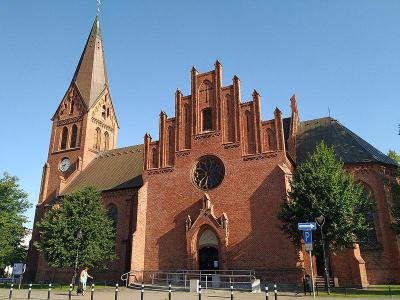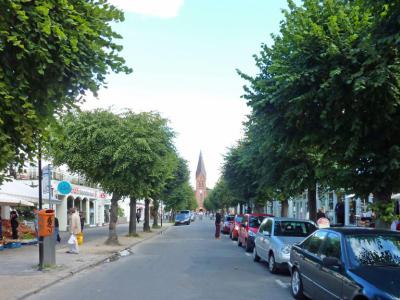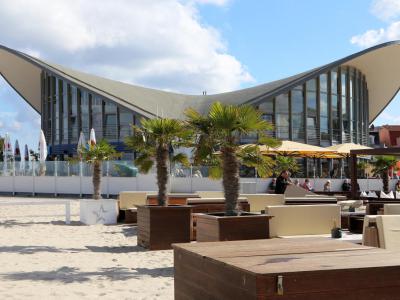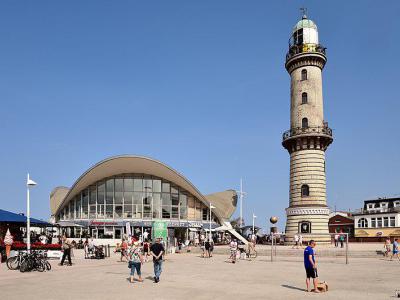Warnemunde Walking Tour (Self Guided), Rostock
A mere 20-minute journey from the charming city of Rostock brings you to Warnemünde, a coastal town renowned for being a prominent stop for cruise ships. Remarkably, it stands as one of the most bustling cruise ports in all of Germany!
As you meander through Warnemünde today, it's hard to imagine its humble beginnings as a quaint fishing village. It was formally integrated into Rostock in 1323, and its identity as a sought-after seaside destination began to flourish during the 1800s.
One of the key locations in Warnemünde is the Old Stream (Alter Strom) Promenade, lined with colorful houses, offering a delightful place to stroll.
As you wander through the streets of Warnemünde, you'll come across the beautiful Warnminner Dealings Fountain (Brunnen Warnminner Umgang). Nearby, Alexandrine Street (Alexandrinenstraße) is a quaint avenue filled with stores and cafes, perfect for shopping or enjoying a cup of coffee.
For those interested in the history of the town, the Local History Museum (Heimatmuseum Warnemünde) provides insight into the area's heritage. The Warnemunde Church, with its distinctive red brick architecture, is another historical gem worth exploring.
Mill Street (Mühlenstraße) showcases the town's lively character, while the beautiful Warnemunde Beach (Strand Warnemünde) is a perfect spot to soak up the sun and enjoy the refreshing Baltic Sea breeze.
Past the beach, you'll be greeted by the Teapot building that resembles its namesake and serves as a popular landmark. Nearby, tall and proud stands the Warnemunde Lighthouse, a towering structure that has guided sailors for over a century, offering breathtaking views of the town and the sea.
Whenever you're in Rostock, make sure to visit Warnemunde and experience the beauty and history of this picturesque part of Germany firsthand. Our self-guided tour will help you with that.
As you meander through Warnemünde today, it's hard to imagine its humble beginnings as a quaint fishing village. It was formally integrated into Rostock in 1323, and its identity as a sought-after seaside destination began to flourish during the 1800s.
One of the key locations in Warnemünde is the Old Stream (Alter Strom) Promenade, lined with colorful houses, offering a delightful place to stroll.
As you wander through the streets of Warnemünde, you'll come across the beautiful Warnminner Dealings Fountain (Brunnen Warnminner Umgang). Nearby, Alexandrine Street (Alexandrinenstraße) is a quaint avenue filled with stores and cafes, perfect for shopping or enjoying a cup of coffee.
For those interested in the history of the town, the Local History Museum (Heimatmuseum Warnemünde) provides insight into the area's heritage. The Warnemunde Church, with its distinctive red brick architecture, is another historical gem worth exploring.
Mill Street (Mühlenstraße) showcases the town's lively character, while the beautiful Warnemunde Beach (Strand Warnemünde) is a perfect spot to soak up the sun and enjoy the refreshing Baltic Sea breeze.
Past the beach, you'll be greeted by the Teapot building that resembles its namesake and serves as a popular landmark. Nearby, tall and proud stands the Warnemunde Lighthouse, a towering structure that has guided sailors for over a century, offering breathtaking views of the town and the sea.
Whenever you're in Rostock, make sure to visit Warnemunde and experience the beauty and history of this picturesque part of Germany firsthand. Our self-guided tour will help you with that.
How it works: Download the app "GPSmyCity: Walks in 1K+ Cities" from Apple App Store or Google Play Store to your mobile phone or tablet. The app turns your mobile device into a personal tour guide and its built-in GPS navigation functions guide you from one tour stop to next. The app works offline, so no data plan is needed when traveling abroad.
Warnemunde Walking Tour Map
Guide Name: Warnemunde Walking Tour
Guide Location: Germany » Rostock (See other walking tours in Rostock)
Guide Type: Self-guided Walking Tour (Sightseeing)
# of Attractions: 9
Tour Duration: 1 Hour(s)
Travel Distance: 1.9 Km or 1.2 Miles
Author: DanaOffice
Sight(s) Featured in This Guide:
Guide Location: Germany » Rostock (See other walking tours in Rostock)
Guide Type: Self-guided Walking Tour (Sightseeing)
# of Attractions: 9
Tour Duration: 1 Hour(s)
Travel Distance: 1.9 Km or 1.2 Miles
Author: DanaOffice
Sight(s) Featured in This Guide:
- Alter Strom Promenade (Old Stream Promenade)
- Brunnen Warnminner Umgang (Warnminner Dealings Fountain)
- Alexandrinenstraße (Alexandrine Street)
- Heimatmuseum Warnemunde (Warnemunde Local History Museum)
- Warnemunde Church
- Mühlenstraße (Mill Street)
- Strand Warnemünde (Warnemunde Beach)
- Teepot (Teapot)
- Warnemunde Lighthouse
1) Alter Strom Promenade (Old Stream Promenade) (must see)
The Alter Strom, a 1,100-meter-long canal connecting Warnemunde to the ferry terminal at the mouth of the Warnow River, has a rich history dating back to 1423 when it was initially excavated and fortified with bulwarks. Until 1903, it served as the primary maritime route from the Baltic Sea to the port of Rostock, as documented in the Rostock council archives.
Located just a brief 5-minute stroll from the train station, the Alter Strom offers direct access to the beach. This picturesque area becomes particularly vibrant on sunny days, attracting visitors with its charming boutiques, restaurants, and vintage houses that line its banks.
Wandering along the Alter Strom, you'll encounter a delightful assortment of inviting cafés, seafood restaurants, and fish market stalls. The presence of moored fishing boats and street performers adds to the lively and quaint atmosphere of this beloved promenade.
Located just a brief 5-minute stroll from the train station, the Alter Strom offers direct access to the beach. This picturesque area becomes particularly vibrant on sunny days, attracting visitors with its charming boutiques, restaurants, and vintage houses that line its banks.
Wandering along the Alter Strom, you'll encounter a delightful assortment of inviting cafés, seafood restaurants, and fish market stalls. The presence of moored fishing boats and street performers adds to the lively and quaint atmosphere of this beloved promenade.
2) Brunnen Warnminner Umgang (Warnminner Dealings Fountain)
The Warnminner Umgang Fountain, situated in Alexandrine Street, is a captivating landmark that pays tribute to the Warnminner dealings-an important local tradition in the town's history. This tradition involved a festive parade of the well-dressed citizens of Warnemunde, which occurred each time the former fishing village appointed a new representative to the city of Rostock.
The fountain artistically brings this historical tradition to life. It features 19 bronze sculptures that seem to move gracefully on the fountain, accompanied by an attractive water feature.
As part of Warnemunder Week, the Warnminner Dealings is reenacted as a lively procession that winds its way through the town center. This fountain serves as a delightful reminder of Warnemunder's rich history and its enduring traditions.
The fountain artistically brings this historical tradition to life. It features 19 bronze sculptures that seem to move gracefully on the fountain, accompanied by an attractive water feature.
As part of Warnemunder Week, the Warnminner Dealings is reenacted as a lively procession that winds its way through the town center. This fountain serves as a delightful reminder of Warnemunder's rich history and its enduring traditions.
3) Alexandrinenstraße (Alexandrine Street)
Alexandrine Street is one of the oldest streets in Warnemünde. Originally known as Achtereeg, which translates to "back row" in High German, it holds a special place in Warnemünde's history. It was one of the very first streets in the area, and its name has undergone changes over time.
In its early days, Alexandrine Street was inhabited by fishermen, sailors, and pilots who lived in small gabled houses. These houses were typically constructed in simple half-timbered style. Notably, the distance between the houses was so narrow that it allowed only for the passage of a pregnant cow, a measurement referred to as "Tüschen," which is a maximum of 1.5 meters wide.
The street's current name, Alexandrine Street, pays tribute to Queen Luise of Prussia. Queen Luise was originally from Mecklenburg, the region where Warnemünde is located.
In its early days, Alexandrine Street was inhabited by fishermen, sailors, and pilots who lived in small gabled houses. These houses were typically constructed in simple half-timbered style. Notably, the distance between the houses was so narrow that it allowed only for the passage of a pregnant cow, a measurement referred to as "Tüschen," which is a maximum of 1.5 meters wide.
The street's current name, Alexandrine Street, pays tribute to Queen Luise of Prussia. Queen Luise was originally from Mecklenburg, the region where Warnemünde is located.
4) Heimatmuseum Warnemunde (Warnemunde Local History Museum)
The Warnemunde Local History Museum offers a fascinating glimpse into the lives of the old Warnemunde residents. Housed in an authentic fisherman's and skipper's house dating back to 1767, this museum allows visitors to step back in time and explore the typical living spaces of the late 19th and early 20th centuries.
As you wander through the museum's rooms, including the "Vörstuw" (parlor), the "Koek" (kitchen), "Achterstuw" (bedroom), and the side "Däl" (hall), you'll gain a direct impression of how the people of Warnemünde once lived. The museum's courtyard is also worth a visit, featuring a typical Warnemunde pear tree, benches, and an herb garden.
Warnemunde was home to sailors, pilots, and fishermen who faced many challenges in their daily lives. The museum's permanent exhibition, spanning 240 square meters, takes you on a voyage of discovery through the history of the town. You'll get a vivid picture of everyday life in Warnemunde during the 19th and early 20th centuries.
On display are artifacts such as an old line rescue wagon used by pilots from 1883, sea chests, nautical equipment used by sailors, and both typical and unusual fishing methods employed by fishermen. You can also delve into the history of one of Warnemünde's most important inventions-the beach chair.
As you wander through the museum's rooms, including the "Vörstuw" (parlor), the "Koek" (kitchen), "Achterstuw" (bedroom), and the side "Däl" (hall), you'll gain a direct impression of how the people of Warnemünde once lived. The museum's courtyard is also worth a visit, featuring a typical Warnemunde pear tree, benches, and an herb garden.
Warnemunde was home to sailors, pilots, and fishermen who faced many challenges in their daily lives. The museum's permanent exhibition, spanning 240 square meters, takes you on a voyage of discovery through the history of the town. You'll get a vivid picture of everyday life in Warnemunde during the 19th and early 20th centuries.
On display are artifacts such as an old line rescue wagon used by pilots from 1883, sea chests, nautical equipment used by sailors, and both typical and unusual fishing methods employed by fishermen. You can also delve into the history of one of Warnemünde's most important inventions-the beach chair.
5) Warnemunde Church
The Warnemunde Church has a history that traces back to the mid-19th century. Construction of the present church commenced in 1866, and its design was masterfully crafted by the esteemed builder Krüger from Schwerin, with construction overseen by master builder Wachenhusen from Rostock. Interestingly, the church was originally erected on the western outskirts of the village but now stands proudly at the center of the community.
Although relatively young in age, the Warnemunde Church boasts a wealth of important historical artifacts that were lovingly transferred from its predecessor. Among these cherished items is the Gothic carved altar, an exquisite masterpiece created by an anonymous master from Gdansk, dating back to before 1475. Equally noteworthy is the statue of Saint Christopher, symbolizing the "Christ-bearer," who carries the Christ child on his shoulder-an artwork that likely hails from a similar period as the altar.
Another unique feature of this church is the ancient clockwork, which has graced the north wing of the church since May 2007, and has been in existence for over 300 years. As you explore the church, you'll also come across around 60 wooden house marks that were once attached to the pews in the old Warnemunde church, providing a fascinating glimpse into the past.
What sets the Warnemunde Church apart are two rare items not commonly found in many churches. In the side aisles, you'll encounter two votive ships, generous donations to the parish from Warnemunde pilot commanders Davids and Jantzen. Additionally, the church features a splendid organ built in 1975 by the renowned Voigt company from Bad Liebenwerda, which fills the sacred space with melodious tones during church services and concerts.
Although relatively young in age, the Warnemunde Church boasts a wealth of important historical artifacts that were lovingly transferred from its predecessor. Among these cherished items is the Gothic carved altar, an exquisite masterpiece created by an anonymous master from Gdansk, dating back to before 1475. Equally noteworthy is the statue of Saint Christopher, symbolizing the "Christ-bearer," who carries the Christ child on his shoulder-an artwork that likely hails from a similar period as the altar.
Another unique feature of this church is the ancient clockwork, which has graced the north wing of the church since May 2007, and has been in existence for over 300 years. As you explore the church, you'll also come across around 60 wooden house marks that were once attached to the pews in the old Warnemunde church, providing a fascinating glimpse into the past.
What sets the Warnemunde Church apart are two rare items not commonly found in many churches. In the side aisles, you'll encounter two votive ships, generous donations to the parish from Warnemunde pilot commanders Davids and Jantzen. Additionally, the church features a splendid organ built in 1975 by the renowned Voigt company from Bad Liebenwerda, which fills the sacred space with melodious tones during church services and concerts.
6) Mühlenstraße (Mill Street)
Mill Street is a charming pedestrian shopping and dining district located in Warnemünde. This historic street, once the site where Napoleon's troops entered the town, has undergone a transformation and is now a vibrant hub filled with bakeries, cafes, restaurants, pubs, and wine shops. The street is designed for pedestrians, creating a relaxed and enjoyable atmosphere for visitors.
Mill Street is lined with quaint bakeries and cafes where you can savor freshly baked goods, enjoy a cup of coffee, or indulge in delicious pastries. The street is also home to a variety of restaurants offering diverse culinary experiences. You can sample regional dishes, international cuisine, seafood specialties, and more. Whether you're looking for a fine dining experience or a casual meal, you'll find options to suit your taste.
Wine enthusiasts can explore wine shops along Mill Street, where you can discover a selection of local and international wines.
Mill Street derives its name from an actual mill constructed in 1866, coinciding with the construction year of the nearby church. Today, this historic mill still stands as a prominent landmark, though it is situated slightly farther to the left, along Laakstrasse.
Mill Street is lined with quaint bakeries and cafes where you can savor freshly baked goods, enjoy a cup of coffee, or indulge in delicious pastries. The street is also home to a variety of restaurants offering diverse culinary experiences. You can sample regional dishes, international cuisine, seafood specialties, and more. Whether you're looking for a fine dining experience or a casual meal, you'll find options to suit your taste.
Wine enthusiasts can explore wine shops along Mill Street, where you can discover a selection of local and international wines.
Mill Street derives its name from an actual mill constructed in 1866, coinciding with the construction year of the nearby church. Today, this historic mill still stands as a prominent landmark, though it is situated slightly farther to the left, along Laakstrasse.
7) Strand Warnemünde (Warnemunde Beach)
The history of Warnemunde dates back to 1323 when Rostock acquired this former fishing village, ensuring free access to the sea. Visitors can conveniently reach Warnemünde Beach by taking the S-Bahn from the center of Rostock, with a short travel time of approximately 20 minutes.
Warnemunde Beach boasts a fine, sandy shoreline that stretches over two kilometers in length and reaches a maximum width of 200 meters. This expansive beach offers ample space for sunbathing, leisurely walks, and various recreational activities. The beach features shallow access to the water, making it ideal for families with children. Visitors can enjoy safe swimming and water play, and the gentle slope into the sea ensures a gradual transition from the shore.
The beach is organized into 24 sections, extending from Westmole to the Stoltera cliffs. Many of these sections are equipped with traditional beach chairs, which are characteristic of Baltic Sea beaches. For added comfort and convenience, consider renting a Strandkorb, a unique covered structure that provides shelter and secure storage for personal belongings while you enjoy the beach. Strandkörbe are iconic beach features commonly found along the Baltic Sea coastline.
Towards the end of the beach, you'll encounter sections 18 to 22 designated as the "FKK" area, which stands for "Freikörperkultur" or naturist/nudist culture. This is a typical feature of German beaches, and visitors should be aware that nudity is common in this specific area.
Warnemunde Beach boasts a fine, sandy shoreline that stretches over two kilometers in length and reaches a maximum width of 200 meters. This expansive beach offers ample space for sunbathing, leisurely walks, and various recreational activities. The beach features shallow access to the water, making it ideal for families with children. Visitors can enjoy safe swimming and water play, and the gentle slope into the sea ensures a gradual transition from the shore.
The beach is organized into 24 sections, extending from Westmole to the Stoltera cliffs. Many of these sections are equipped with traditional beach chairs, which are characteristic of Baltic Sea beaches. For added comfort and convenience, consider renting a Strandkorb, a unique covered structure that provides shelter and secure storage for personal belongings while you enjoy the beach. Strandkörbe are iconic beach features commonly found along the Baltic Sea coastline.
Towards the end of the beach, you'll encounter sections 18 to 22 designated as the "FKK" area, which stands for "Freikörperkultur" or naturist/nudist culture. This is a typical feature of German beaches, and visitors should be aware that nudity is common in this specific area.
8) Teepot (Teapot)
The Teapot stands out for its architectural style known as "Hypar shell architecture." This innovative design was created by civil engineer Ulrich Müther from Binz. The tea pavilion was originally constructed in 1927/28, but it faced unfortunate destruction by fire in 1945.
In 1968, the tea pavilion was rebuilt with a playful and imaginative twist. This whimsical redesign gave the building its iconic appearance and earned it the nickname "Teepot." Due to its exceptional and distinctive roof construction, the Teepot was recognized as a listed building.
In 2002, the Teepot underwent a renovation, ensuring its preservation and functionality for future generations. Since then, it has been transformed into a gastronomic venue, offering a variety of dining and refreshment options.
In 1968, the tea pavilion was rebuilt with a playful and imaginative twist. This whimsical redesign gave the building its iconic appearance and earned it the nickname "Teepot." Due to its exceptional and distinctive roof construction, the Teepot was recognized as a listed building.
In 2002, the Teepot underwent a renovation, ensuring its preservation and functionality for future generations. Since then, it has been transformed into a gastronomic venue, offering a variety of dining and refreshment options.
9) Warnemunde Lighthouse (must see)
The Warnemunde Lighthouse stands tall at a height of 31 meters and is constructed using gleaming white glazed bricks. Offering breathtaking panoramic vistas of Warnemünde, the Baltic Sea, and the pristine beach, this lighthouse is not only a navigational aid for ships approaching the harbor but has also become the defining symbol of the seaside resort.
Erected during the years 1897 and 1898, this historic lighthouse served as an essential maritime beacon for vessels at sea. Its guiding light not only ensured safe passage for ships into the harbor but also added to the allure of Warnemunde. This lighthouse is visible from nearly every corner of Warnemunde, and for those who venture inside its towering structure, it offers an awe-inspiring view of the resort town.
At the lighthouse's base, you'll find a commemorative plaque marking the location of the former pilot station, bearing the inscription "The last house before Denmark." This inscription is a poignant reminder of the Great Flood that ravaged the area in 1872. Protecting the harbor entrance are jetties that stand as resilient barriers against the forces of nature.
Visitors to the Warnemunde Lighthouse have the opportunity to ascend its heights via a spiral granite staircase. In the 1960s, the lighthouse showed signs of structural wear and tear, prompting restoration efforts that began in 1969. This meticulous restoration process wasn't completed until 1993. Since then, the lighthouse has once again opened its doors to visitors, offering them the chance to climb to its summit. This experience has become an essential part of local tourism, allowing guests to marvel at the spectacular views that this historic beacon has to offer.
Erected during the years 1897 and 1898, this historic lighthouse served as an essential maritime beacon for vessels at sea. Its guiding light not only ensured safe passage for ships into the harbor but also added to the allure of Warnemunde. This lighthouse is visible from nearly every corner of Warnemunde, and for those who venture inside its towering structure, it offers an awe-inspiring view of the resort town.
At the lighthouse's base, you'll find a commemorative plaque marking the location of the former pilot station, bearing the inscription "The last house before Denmark." This inscription is a poignant reminder of the Great Flood that ravaged the area in 1872. Protecting the harbor entrance are jetties that stand as resilient barriers against the forces of nature.
Visitors to the Warnemunde Lighthouse have the opportunity to ascend its heights via a spiral granite staircase. In the 1960s, the lighthouse showed signs of structural wear and tear, prompting restoration efforts that began in 1969. This meticulous restoration process wasn't completed until 1993. Since then, the lighthouse has once again opened its doors to visitors, offering them the chance to climb to its summit. This experience has become an essential part of local tourism, allowing guests to marvel at the spectacular views that this historic beacon has to offer.
Walking Tours in Rostock, Germany
Create Your Own Walk in Rostock
Creating your own self-guided walk in Rostock is easy and fun. Choose the city attractions that you want to see and a walk route map will be created just for you. You can even set your hotel as the start point of the walk.
Rostock Introduction Walking Tour
According to Germany's prestigious Historic Highlights list, the lovely town of Rostock on the Baltic Coast is one of the country's 16 lesser-known destinations that you may wish to explore. They say a day trip here is a must for anyone visiting Berlin or Hamburg.
Rostock was originally founded by Polabian Slavs in the 11th century as "Roztoc," which means "fork of a... view more
Tour Duration: 2 Hour(s)
Travel Distance: 2.9 Km or 1.8 Miles
Rostock was originally founded by Polabian Slavs in the 11th century as "Roztoc," which means "fork of a... view more
Tour Duration: 2 Hour(s)
Travel Distance: 2.9 Km or 1.8 Miles
The Most Popular Cities
/ view all













